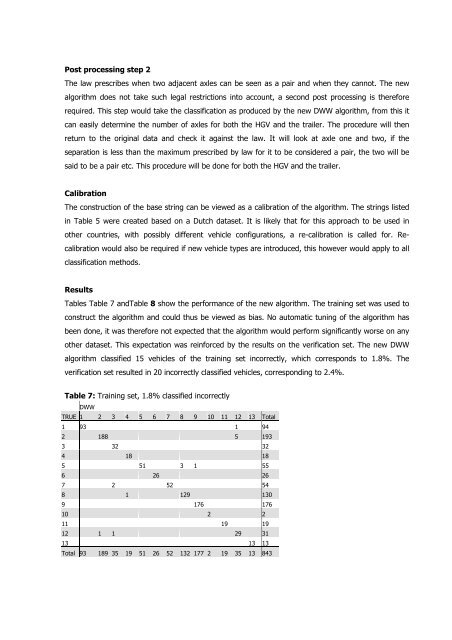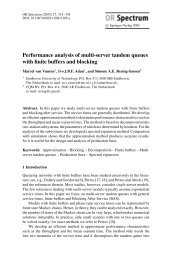Weigh-in-Motion â Categorising vehicles - Cqm
Weigh-in-Motion â Categorising vehicles - Cqm
Weigh-in-Motion â Categorising vehicles - Cqm
Create successful ePaper yourself
Turn your PDF publications into a flip-book with our unique Google optimized e-Paper software.
Post process<strong>in</strong>g step 2<br />
The law prescribes when two adjacent axles can be seen as a pair and when they cannot. The new<br />
algorithm does not take such legal restrictions <strong>in</strong>to account, a second post process<strong>in</strong>g is therefore<br />
required. This step would take the classification as produced by the new DWW algorithm, from this it<br />
can easily determ<strong>in</strong>e the number of axles for both the HGV and the trailer. The procedure will then<br />
return to the orig<strong>in</strong>al data and check it aga<strong>in</strong>st the law. It will look at axle one and two, if the<br />
separation is less than the maximum prescribed by law for it to be considered a pair, the two will be<br />
said to be a pair etc. This procedure will be done for both the HGV and the trailer.<br />
Calibration<br />
The construction of the base str<strong>in</strong>g can be viewed as a calibration of the algorithm. The str<strong>in</strong>gs listed<br />
<strong>in</strong> Table 5 were created based on a Dutch dataset. It is likely that for this approach to be used <strong>in</strong><br />
other countries, with possibly different vehicle configurations, a re-calibration is called for. Recalibration<br />
would also be required if new vehicle types are <strong>in</strong>troduced, this however would apply to all<br />
classification methods.<br />
Results<br />
Tables Table 7 andTable 8 show the performance of the new algorithm. The tra<strong>in</strong><strong>in</strong>g set was used to<br />
construct the algorithm and could thus be viewed as bias. No automatic tun<strong>in</strong>g of the algorithm has<br />
been done, it was therefore not expected that the algorithm would perform significantly worse on any<br />
other dataset. This expectation was re<strong>in</strong>forced by the results on the verification set. The new DWW<br />
algorithm classified 15 <strong>vehicles</strong> of the tra<strong>in</strong><strong>in</strong>g set <strong>in</strong>correctly, which corresponds to 1.8%. The<br />
verification set resulted <strong>in</strong> 20 <strong>in</strong>correctly classified <strong>vehicles</strong>, correspond<strong>in</strong>g to 2.4%.<br />
Table 7: Tra<strong>in</strong><strong>in</strong>g set, 1.8% classified <strong>in</strong>correctly<br />
DWW<br />
TRUE 1 2 3 4 5 6 7 8 9 10 11 12 13 Total<br />
1 93 1 94<br />
2 188 5 193<br />
3 32 32<br />
4 18 18<br />
5 51 3 1 55<br />
6 26 26<br />
7 2 52 54<br />
8 1 129 130<br />
9 176 176<br />
10 2 2<br />
11 19 19<br />
12 1 1 29 31<br />
13 13 13<br />
Total 93 189 35 19 51 26 52 132 177 2 19 35 13 843



